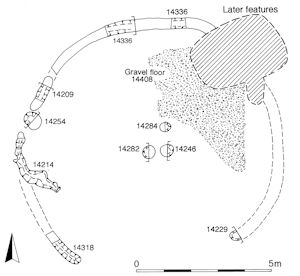
The second phase of use of Open Area 27 simply constitutes prolonged continuity of activity within this enclosure. Its buildings and pits are replaced over time, but the essence of its functional nature remains the same through this mid-1st century AD phase. Stratigraphically later still 2B activity within OA27 is described here.

Mid-1st century AD roundhouse Building 36 (Figure 42) is defined by a series of intermittent, arcing slots of varying length (14209, 14214, 14318, 14336, Group 250), which are interpreted as constituting a wall foundation rather than an eves-drip gully. The interruption of the slots may be a result of truncation. Although the eastern half of the building is truncated or obscured by pits (some unexcavated), it is possible to reconstruct this structure as being c. 9.4-9.6m in diameter (an internal area of c. 60m²). Post-holes 14246 or 14282 (Group 251) could constitute the location of a central roof support within this building. On the east side of the roundhouse interior is gravel layer 14408 (Group 252). Up to 0.13m deep, it is probably the remnant of a floor surface. The mid-1st century date for the building is derived from small quantities of unexceptional pottery from the remains of the building itself (14209, 14246, 14254, 14336, 14408), comprising mainly grog-tempered sherds but with a few sherds of black-surfaced wares, and from the pits (Group 258), which it post-dates.
Located in the southern part of the enclosure, close to the terrace edge and alongside Building 29, Building 36 could be construed as a successor - or even its contemporary, which endures into the LIA-Roman transition period.
Structure 20 lies immediately north of Building 36. Defined by gently curving cut 25073 (segs 14219, 14237, 14362 Group 253), some 9.5m long, 0.75m wide and up to 0.5m deep, this is a relatively substantial gully. A terminal at its north end is extant while its south terminal is truncated by pit 14382 (Group 260). Post-holes 14474, 14536 and 14542 (Group 254) are set into its base and help signal that the gully is indeed structural. It is unlikely that Structure 20 denotes a circular building (such a structure would have been c. 20m in diameter). It is more likely to define the line of a length of screening fence around hearth 14500 (Group 255). Structure 20 post-dates Building 29 and may be contemporary with Building 36.
The fills (14362) of slot 25073 contain handmade grog-tempered forms in addition to a sherd of white-slipped Central Gaulish ware, which tentatively date its filling to the Late Iron Age.
Cut 14500 is an L-shaped cut 1.25m long, the shape of which suggests a flue arrangement. No hearth superstructure survives. While there was no in situ evidence from the hearth to define its function, adjacent pit 14382 (Group 260), which truncates the south end of Structure 20, contains mould fragments, cast waste (SF8369, SF6228) and slag derived from metalworking. Finds from this pit also include cosmetic tools (SF5544). As this pit post-dates Structure 20, if it does reflect the use of the hearth, then the screen appears to have fallen out of use before the hearth itself. The burnt clay fill of the hearth (Group 255) includes pottery consistent with a mid-1st century date.
At the north end of OA27, a curving slot 25152 (segs 14842, 14844, 20161, 20314 Group 265), never more than 0.37m wide or 0.14m deep, is located immediately south of Road/track 3. Post-hole 20332 (Group 266) lies on the arc. Though truncated by Roman pits, the slot is intermittently traced for 14m, defining approximately half of a circle of 13m diameter. If originally complete, the circle would have enclosed an area of 132m². The small quantity of pottery recovered from the slot (seg. 20314) is consistent with a Late Iron Age date, up to the mid-1st century AD. Much of the area within the arc has been lost to later pitting and no trace of associated structural features is evident. A function as the foundation of a curving screening fence is more likely than that of a roundhouse.
Hearth 14990/14977 (see below) is possibly associated, with Structure 21 perhaps constituting a wind-break.
Two small pits, 14912 and 14977/14990 (Group 267), lie within the arc of Structure 21. While 14912 is rounded and 1477/14990 rectangular, both are lined with orange clay. The latter is clearly re-cut and re-lined. Although neither shows much sign of in situ burning, their function as hearths is speculated. Their component finds give little further indication of use, perhaps because these features are regularly cleaned out, but the pottery assemblage contains small quantities of Roman wares in addition to grog-tempered material (which is predominant) and Gallo-Belgic wares. Their filling is likely to begin in the early 1st century AD, continuing into the mid-1st century AD.
Internet Archaeology is an open access journal based in the Department of Archaeology, University of York. Except where otherwise noted, content from this work may be used under the terms of the Creative Commons Attribution 3.0 (CC BY) Unported licence, which permits unrestricted use, distribution, and reproduction in any medium, provided that attribution to the author(s), the title of the work, the Internet Archaeology journal and the relevant URL/DOI are given.
Terms and Conditions | Legal Statements | Privacy Policy | Cookies Policy | Citing Internet Archaeology
Internet Archaeology content is preserved for the long term with the Archaeology Data Service. Help sustain and support open access publication by donating to our Open Access Archaeology Fund.